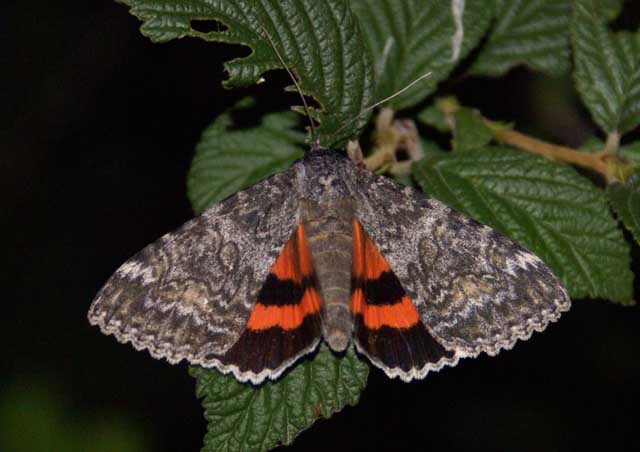Little Yellow-Orange Underwings: Wingspans: 35-50mm
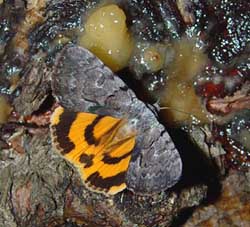
| ** 8846 sordida WO;
Sordid Underwing; 37-45mm.
Fw lighter along costa, darker along inner
margin. Dark medial lines especially evident through lighter
shades near costa. Outer black hw band broken
near anal angle.
Determination on moth to right based on
dark scaling along inner margin limited to median area
and submarginal "teeth" relatively short, blunt.
Tim Dyson image.
|
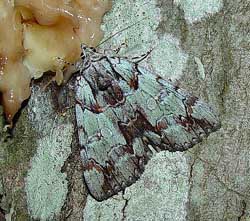
| ** 8865
praeclara; Praeclara Underwing,
40-50mm. Fw pale greenish-grey with considerable contrasting
brown shading beyond pml.
Black basal dash very close to inner margin,
another dash, higher up in median area.
Note contrasting shapes of reniform & subreniform spots.
Upper of two larger pml teeth longer, wider than lower tooth.
Note double, white filled amls.
Lighter, subcircular patch, outlined in black, brown on lower thorax.
|
Catocala praeclara, Regina, August 2008, Tim Taylor

| ** 8865
praeclara manitoba; Manitoba Underwing, 40-50mm
The forewing am line is black and distinct, oblique in its upper half and perpendicular to the inner margin
in its lower half. There is a distinct, narrow, white, toothed subterminal band.
The hindwing loop is complete.
|
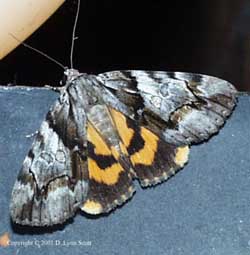
| ** 8867 Catocala blandula WO;
Charming Underwing; 40-50mm.
Fw pale basal area distinguishes mira from
blandula (dark brown) & crataegi (black).
Fw has dark contrasting lines as in crataegi.
Considerable brown in subterminal area &
subreniform spot very conspicuous, usually brown.
Light area runs obliquely from costa to subreniform spot.
Hindwing deep orange & has complete inner black band.
Puter black band usually unbroken.
Lynn Scott image.
|
Catocala blandula males (3), Lumsden, Saskatchewan, July 19, 2010, Tim Taylor.

| ** 8775 antinympha;
Sweetfern Underwing, 45-55mm.:
Very dark grey, almost black, forewing ground colour
distinguishes antinympha. Some brown shading in
subreniform spot & also just outside pml.
Hindwing: amber to pale orange.
There is also form multoconspicua Reiff, 1919 with pale,
almost white subreniform spot. Tim Dyson image.
|
Little Yellow-Orange Underwings: Wingspans: 35-56mm
These tend to be slightly larger on average than preceding group.
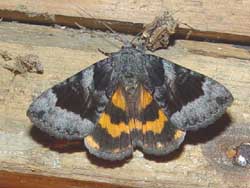
| ** 8776 badia coelebs;
Old Maid Underwing, 54-56mm.
Gray region from forewing pml to outer margin readily
distinguishes this species. Fringe gray on lower wing from brief orange dash at hindwing apex to
anal angle. Tim Dyson image. Questionable in Saskatchewan.
|
|
Midsized Orange-Salmon-Red-Scarlet Underwings: Wingspans: 50-72mm
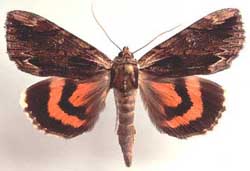
| ** 8857 Catocala ultronia;
Ultronia Underwing, 50-63mm.
Fws typically gray-brown, with distinct & very
dark inner margin & characteristic light brown patch, underscored
by very dark arc, near wingtip.
Underwings can be yellow to orange to salmon.
|
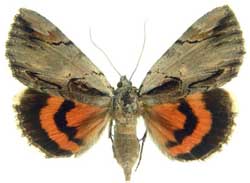
| ** 8857 Catocala ultronia form lucinda;
Ultronia Underwing, 50-63mm.
In form lucinda most of forewing
is bright grey. On all forms there is
extensive orange-salmon colouration on hw ventral surface,
with dark discal lunule.
|
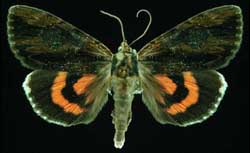
| Catocala ultronia,
form nigrescens.
Melanic form nigrescens, dorsal forewing very dark.
Even darker subapical arc, basal dash & dash near anal angle still visible.
Dark basal hairs on hindwing.
Harold J. Vermes slide, used with permission from his son.
|

| Catocala ultronia form celia.
In form celia wide, light grey band separating dark region along inner margin & dark patch near apex.
Ventral surface of forewings of all forms has generous suffusion
of orange-salmon scales in e lower half of median area.
|
Catocala ultronia, Regina, August 24, 2009, courtesy of Tim Taylor
Catocala ultronia, near Lumsden, July 25, 2010, courtesy of Tim Taylor.
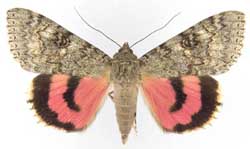
| Catocala hermia;
Hermia Underwing: 58-68mm; pinkish:
Fw almost uniform, grey-brown or clay coloured; thin, yet contrasting lines.
Distinct large double reniform spot. Large concolourous subrenifrom spot usually open.
Hw pinkish red, relatively even, narrow black bands. Inner black band ends before im.
Fringe white, checked, pink/red "bleeding" along outer band, near apex.
|

| Catocala hermia form vesta;
Hermia Underwing: 58-68mm; pinkish:
Fw almost uniform, very dark grey; thin, yet contrasting lines.
Distinct large double reniform spot. Large concolourous subrenifrom spot usually open.
Hw pinkish red, relatively even, narrow black bands. Inner black band ends before im.
Fringe white, checked, pink/red "bleeding" along outer band, near apex.
|

| #8817
briseis TT;
Briseis Underwing; 60-70mm;
Fws predominantly mottled dark-grey-brown with some lighter areas 1) between postmedial & subterminal lines, 2) at base of am & pm
lines along inner margin, 3) over subreniform spot running diagonally toward costa.
Pm lines do not have greatly elongated & sharly pointed "teeth" near apex.
Hw fringe white & unbroken, inner black band (fairly even) reaches inner margin.
Tim Dyson image.
|
Catocala briseis, Regina, August, 2008, Tim Taylor

| ** 8851
Catocala coccinata TM;
Scarlet; 57-70mm.
Usually diffuse basal & anal dashes on otherwise light
grey, mottled forewing.
Hw fringe white (often with some salmon scaling),
heavily checked.
"Tooth" just below pair of very elongated "teeth"
much reduced & quite rounded, usually allowing considerable room
for lighter patch. Dark bar crosses thorax.
Reniform spot tends be to light, often with greenish cast.
Joe Garris image.
|
|
Large Black Underwings (Banded): Wingspans: 70-80mm
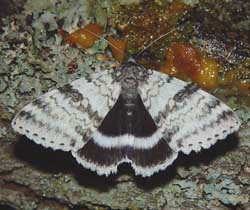
| ** 8803
Catocala relicta TT;
Forsaken, White, Relict; 70-80mm.
Considerable variation with regard to black/white
concentrations on forewings.
Form clara (depicted), has basal and subterminal
areas predominantly white; form phrynia, is
evenly dusted with grey over entire forewing.
Typical specimens have basal & subterminal areas filled with
blackish scales. Distinctive hws black with brilliant even white
inner band and
white fringe.
|
Catocala relicta, aproaching bait trap, Regina, August 17, 2009;
recto and verso, August 18, 2009, Tim Taylor
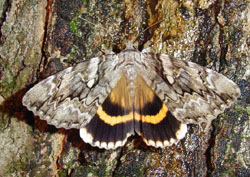
| ** 8802
Catocala cerogama;
Yellow-Banded; 70-80mm.
Several different forms. Pm line distinct, dark
with elongate pair of projections. Pm & am lines meet i.m.
in relative proximity. Closed subreniform spot
lighter than surrounding areas, shaped like an
arrowhead with point toward body. Hindwings
distinctive. Jean-Benoit Duval image. |
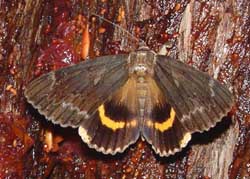
| ** 8802
Catocala cerogama;
Yellow-Banded; 70-80mm.
Form ruperti: Forewings are almost uniform grey-brown with white scales outlining subterminal line.
The hindwings are
distinctive. Tim Dyson image. |
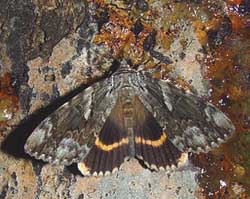
| ** 8802
Catocala cerogama;
Yellow-Banded; 70-80mm.
Form bunkeri: Forewings dark in median & basal areas.
Hw golden band reduced in thickness. Basal hairs brown instead of yellow.
Hindwings distinctive. Tim Dyson image. |
Large Orange-Salmon Underwings: Wingspans: 65mm, usually 70-95mm
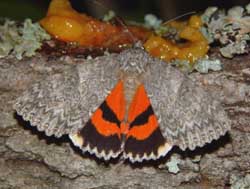
| ** 8822
meskei TT; Meske's Underwing;
65-75mm.
Fws less distinctly marked compared to unijuga,
some red-orange at hindwing apex & just inside
fringe along outer margin in meskei, lacking in unijuga.
Fw subreniform spot opened or connected to
postmedian line. Hw postmedian band nearly straight,
turned in & tapering near anal angle.
Tim Dyson image. |
Catocala meskei, Regina, August, 2008-09, Tim Taylor.
Catocala meskei, Regina, July 21, 2010, Tim Taylor.
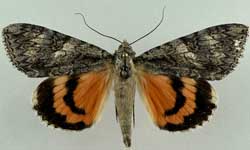
| ** 8822a
orion Orion Underwing. 50-75mm. Very similar to Meske’s, slightly smaller. Tends to have narrower forewings, with fw cooler grey, more heavily stippled with black & white.
HW black band more sharply angled in middle. Flies later in season than Meske’s, often into Oct.
|
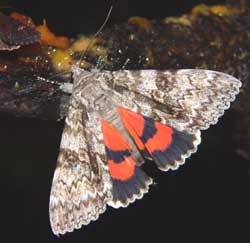
| ** 8821
semirelicta; Semirelict Underwing;
65-75mm.
Fw ground colour white with dark lines & shadings.
Diffuse dark bar runs from center of basal area to outer margin a
few mm above anal angle. Regular dentation of st line.
Inner black bar on hw usually terminates well before
inner margin.
Form "atala" has uniformly grey fw.
Unijuga usually larger & has less contrasting black lines.
inner black bar on unijuga usually reaches i. m.
Tim Dyson image.
|
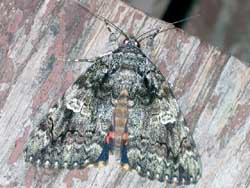
| ** 8801
Catocala ilia; Ilia;
wingspan: 65-82mm.
Several different forms,
most have characteristic white area in & around
reniform spot. Diffuse dark arc runs from spot to just below apex. Subreniform spot squarish, concave inner & outer edges
& elongated constriction connecting it to pml.
White dots near fw o. m. in character
with overall "contrasting" appearance.
|
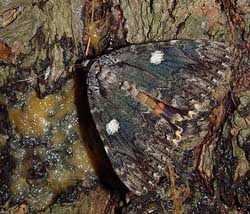
| ** 8801
Catocala ilia; Ilia;
form conspicua
In this form the entire reniform spot is heavily suffused with white scaling on
an otherwise darker ground colour. Hence the form name "conspicua".
Tim Dyson image.
|
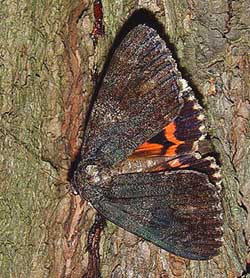
| ** 8801
Catocala ilia; Ilia;
form satanas
In this melanic form the entire forewing, including the reniform spot is very dark. Hence the form name "satanas".
The dark basal streak is still evident on this form.
Tim Dyson image.
|
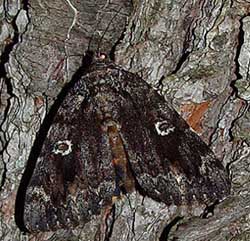
| ** 8801
Catocala ilia; Ilia;
form normani
In this semi-melanic form the entire forewing, excluding reniform spot, is relatively dark.
Brownish, kidney-shaped center of reniform spot is outlined in white.
Basal streak and subapical arc are still visible.
Tim Dyson image.
|
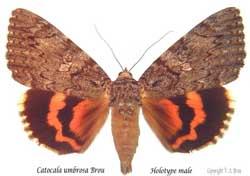
| ** 8857.1
Catocala umbrosa;
mm;
Double brown am line, inward line fainter, filled with off white; reniform spot brown
center outlined in black, off white & black again; subreniform, large, pale brown, closed.
Pm line with two elongated upper teeth, next tooth reduced, next two progressively longer, rounded,
final lobe rounded & shorter. HW with dark scaling/hairs in basal median area along im.
Very similar to ilia, possibly in southern central Saskatchewan (Larry Gall)
|
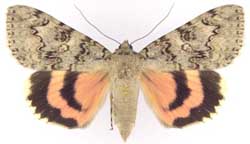
| ** 8808 luciana;
Luciana Underwing; 70-80mm.
Luciana has pale grey brown fw with very distinct am
& pm lines.
Subreniform spot has elongated narrow "tail" that seems to
open through postmedial line. Hw inner black band does not reach inner margin.
Fringe checked & paler (almost yellow) than
salmon ground colour.
|
Catocala luciana m, Willow Bunch, N49 28.711 W105 39.186, Sept 26 2011, 22C
Catocala luciana f, Bengough, N49 30.268 W105 04.711, Sept 23 2011, 2311ft. 24C
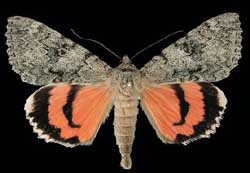
| Catocala junctura;
Joined Underwing; 67-85mm.
Fw usually dark brownish-gray to evenly powdered
blue-grey w/o significant markings. Doubled reniform spot
often obscure. Thin, slightly darker am & pm
lines run from costa to im & are not widely
spaced at im.
Hw salmon or orange-pink, narrow inner black band
turns in sharply, does not meet dark-haired im,
distinguishing it from unijuga.
Gary Anweiler image. |
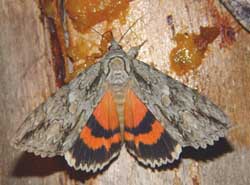
| ** 8806 Catocala parta;
Mother Underwing; 70-85mm.
Black dashes in basal, subapical & anal areas help to
identify this species. Hws may be yellow to
yellowish-orange, more often are salmon-red. Note
face-head-like markings on thorax.
In hw, first (nearest apex) black protrusion into
white fringe is "noticeably" larger than others.
|
Catocala parta, Regina, August 12-25, 2008, courtesy of Tim Taylor.

| ** 8805 unijuga;
Once-married; 70-90mm. Unijuga has
fairly wide black hw inner band (almost reaching inner margin), dark hairs in basal-median area along hw im;
very distinctive patterning in forewing.
Meskei tend to have narrower band and dustier (less distinct) looking fw.
Semirelicta tend to have inner bands that terminate well before
inner margins. Also note the very white fringe on both the forewings and hindwings.
Carroll Rudy image.
|
Catocala unijuga form agatha, July 27, 2010, Regina, courtesy of Tim Taylor.
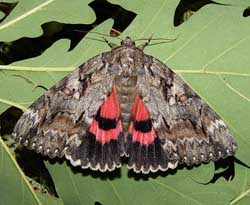
| aholibah;
80-90mm: Fw is mix of grey & brown, with preponderance of brown in subterminal area.
Double reniform spot has diffuse brown outline of inner oval. Subreniform spot small,
distinctly outlined in black,
light coloured & does not connect to pm line. Upper two teeth of pml elongate,
followed by relatively smooth line til next tooth below subreniform spot.
Hindwing salmon or pinkish.
|
|
Medium-Large Pink Underwings: Wingspans: 70-95mm
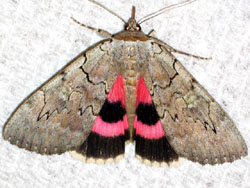
| ** 8833 concumbens
Sleepy Underwing or
Pink Underwing; 60-75mm.
Brown thoracic collar quite evident in this image as is
interruption in pm line by open subreniform spot.
White hw fringe only lightly checked
on wing veins. Vibrant pink bans
distinct in colour & also in their relatively smooth contour.
|
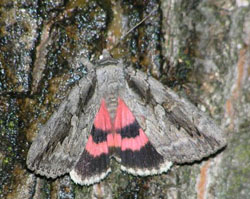
|
** 8834 amatrix
Sweetheart Underwing; (wingspan 75-95mm).
Very skittish, frequently hides in caves, under
bridges, under tree bark, etc. by day, resting with head down.
Hw patterning and colouration similar to that of
C. concumbens, but large size (wingspan 75-95mm)
and dark bar running from basal area to just below apex
distinguishes C. amatrix. See large
Catocala amatrix courtesy of
Joan F. Rickert.
|
Catocala amatrix female, 80 mm, Willow Bunch; N49 28.711
W105 39.186, Sept 26, 2011, 22C
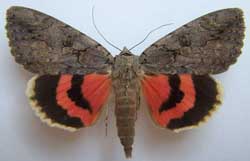
|
** 8834 amatrix form selecta
Sweetheart Underwing; (wingspan 75-95mm)
Very skittish and frequently hides in caves, under
bridges, under tree bark, etc. by day, resting with head down.
Several forms, including selecta (to the left)
which lacks dark bar on forewing. Hesseli: melanic form;
pallida: very pale form.
|
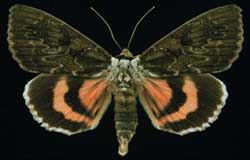
|
** 8834 amatrix form hesseli
Sweetheart Underwing; (wingspan 75-95mm)
Very skittish and frequently hides in caves, under
bridges, under tree bark, etc. by day, resting with head down.
The melanic form hesseli is very dark and displays dark basal hairs in the hindwing.
|
|
|
